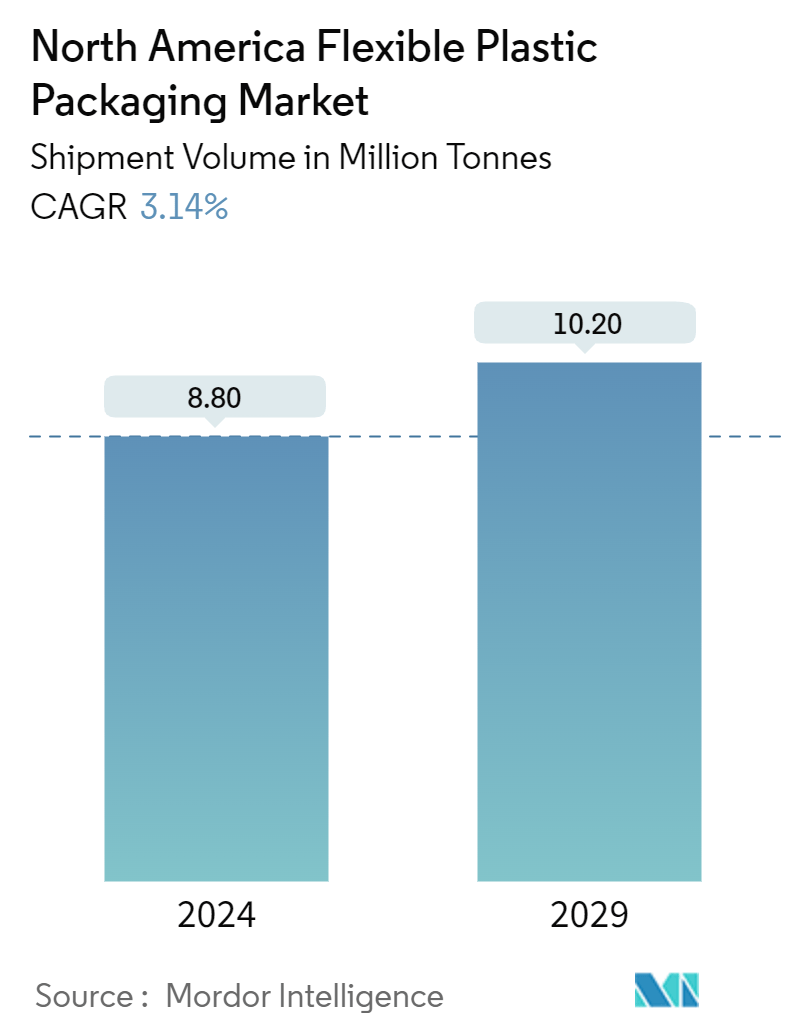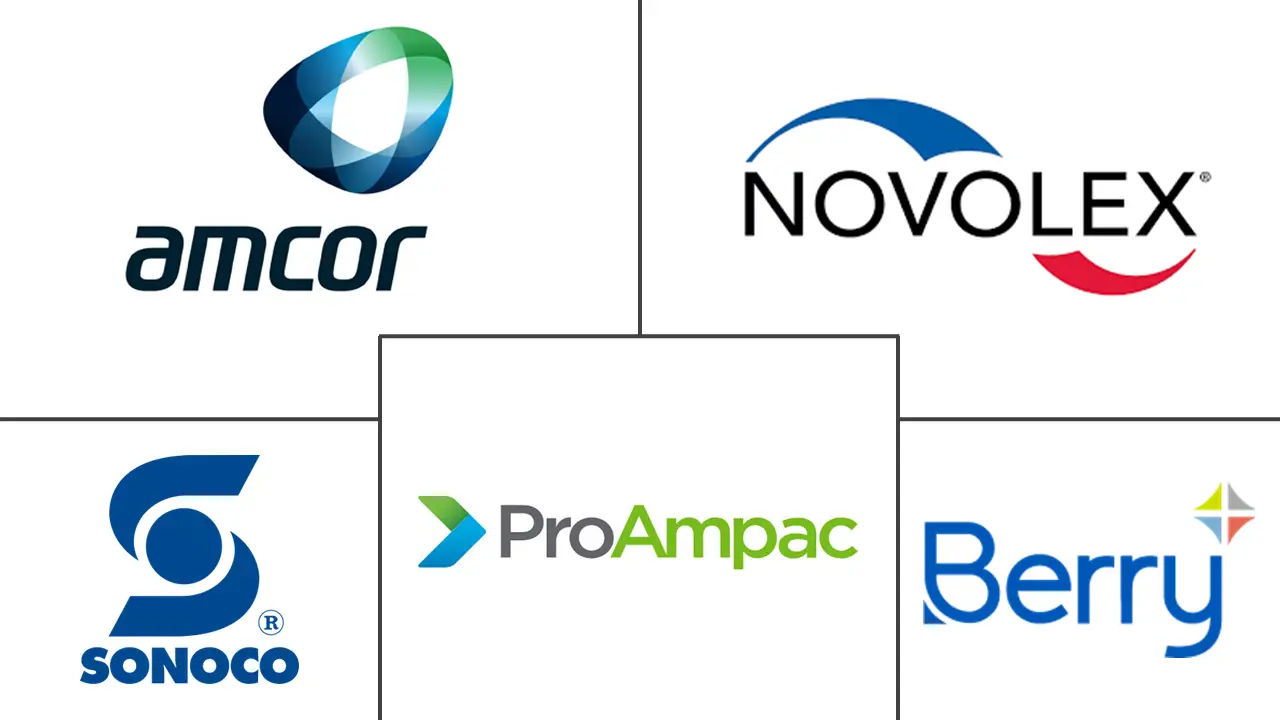Market Size of North America Flexible Plastic Packaging Industry

| Study Period | 2019 - 2029 |
| Base Year For Estimation | 2023 |
| Market Volume (2024) | 8.80 Million tonnes |
| Market Volume (2029) | 10.20 Million tonnes |
| CAGR (2024 - 2029) | 3.14 % |
| Market Concentration | Low |
Major Players
*Disclaimer: Major Players sorted in no particular order |
North America Flexible Plastic Packaging Market Analysis
The North America Flexible Plastic Packaging Market size in terms of shipment volume is expected to grow from 8.80 Million tonnes in 2024 to 10.20 Million tonnes by 2029, at a CAGR of 3.14% during the forecast period (2024-2029).
- The demand for flexible plastic packaging is rising, driven by a surge in consumer products like food, beverages, and cosmetics. This uptick is mainly due to the convenience and portability offered by modern packaging solutions. As urban lifestyles evolve, consumers increasingly favor packaging that's not just lightweight but also easy to use. In response, vendors are innovating, ensuring their packaging remains competitive in the shifting landscape of organized retail.
- There's a growing push to infuse technology into packaging, spurred by the need for better barrier qualities, product innovation, and the digitization of supply chains. The region's food ingredients market is flourishing, propelled by a booming food and beverage industry, a rising appetite for dairy products, and a heightened demand for processed and packaged foods. Flexible plastic packaging emerges as the go-to choice, especially as the need for portable and convenient food packaging escalates across industries.
- Highlighting the trend, the US Census Bureau reported that between April and June 2023, retail e-commerce sales in the United States reached nearly USD 277.6 billion, a significant uptick from the previous quarter. This surge in e-commerce sales is nudging regional players in flexible plastic packaging to innovate and expand their market reach to meet diverse customer needs.
- As the consumption of confectionaries and sweets rises, flexible plastic packaging firms are tailoring their products to this niche, boosting sales. For instance, data from the United States Census Bureau projects that the confectionery industry's revenue in the United States could hit USD 10.89 billion by FY 2023.
- Industry players actively invest in new product development to meet customer demands. For instance, in August 2023, TC Transcontinental Packaging announced a hefty USD 60 million investment. This funding is earmarked for cutting-edge mono-material recyclable flexible plastic packaging solutions featuring high-performance polyethylene films with enhanced heat resistance. The investment also includes a groundbreaking film line that will produce biaxially oriented polyethylene (BOPE), a first in North America, and a significant expansion of TC Transcontinental Packaging's Spartanburg, South Carolina facility.
- As sustainability takes center stage, manufacturers in the flexible plastic packaging and consumer packaged goods (CPG) sectors are pivoting toward eco-friendly options. These include incorporating post-consumer recycled (PCR) content, utilizing biodegradable materials, transitioning from multi-layer to mono-material structures, and substituting plastic with paper. While these changes are laudable, they pose operational challenges, especially in transitioning between different flexible materials.
North America Flexible Plastic Packaging Industry Segmentation
Flexible plastic packaging allows more economical and customizable options for packaging products. Flexible plastic packaging products are particularly useful in industries requiring versatile packaging, such as the food and beverage, personal care, and pharmaceutical industries. It has gained popularity due to its high efficiency and cost-effectiveness. Flexible plastic packaging combines the advantages of plastic materials such as PE and PP without compromising the product's printability, barrier protection, freshness, or ease of use. Consumers are looking for easy-to-use and lightweight packaging, and vendors are designing innovative packaging solutions to remain competitive in the growing organized retail market with the changing demands of customers. Shifting to an alternative lighter material, such as flexible pouches, provides more significant energy-saving benefits.
The North America Flexible Plastic Packaging Market Report is Segmented by Material (Polyethene [PE], Bi-Oriented Polypropylene [BOPP], Cast Polypropylene [CPP], Polyvinyl Chloride [PVC], Ethylene Vinyl Alcohol [EVOH], and Other Material Types [Polycarbonate, PHA, PLA, Acrylic, and ABS]), Product Type (Pouches, Bags, Films and Wraps, and Other Product Types), End-User Industry (Food [Frozen Food, Dry Food, Meat, Poultry, and Sea Food, Candy & Confectionery, Pet Food, Dairy Products, Fresh Produce and Other Food (Seasonings & Spices, Spreadables, Sauces, Condiments, etc.)], Beverage, Medical and Pharmaceutical, Personal Care and Household Care, and Other End User Industry [Automotive, Chemical, Agriculture ]), and Country (United States and Canada). The report offers market forecasts and size in volume (tonnes) for all the above segments.
| By Material Type | |
| Polyethene (PE) | |
| Bi-oriented Polypropylene (BOPP) | |
| Cast Polypropylene (CPP) | |
| Polyvinyl Chloride (PVC) | |
| Ethylene Vinyl Alcohol (EVOH) | |
| Other Material Types (Polycarbonate, PHA, PLA, Acrylic, and ABS) |
| By Product Type | |
| Pouches | |
| Bags | |
| Films and Wraps | |
| Other Product Types (Blister Packs, Liners, etc.) |
| By End-user Industry | ||||||||||
| ||||||||||
| Beverage | ||||||||||
| Personal Care and Household Care | ||||||||||
| Medical and Pharmaceutical | ||||||||||
| Other End user Industries ( Automotive, Chemical, Agriculture) |
| By Country | |
| United States | |
| Canada |
North America Flexible Plastic Packaging Market Size Summary
The North American flexible plastic packaging market is experiencing significant growth, driven by the increasing demand for convenient and portable packaging solutions across various consumer sectors, including food, beverages, and cosmetics. As urban lifestyles evolve, there is a notable shift towards lightweight and user-friendly packaging, prompting vendors to innovate and enhance their offerings. The integration of technology into packaging solutions is becoming more prevalent, addressing the need for improved barrier qualities and supporting the digitization of supply chains. The flourishing food and beverage industry, coupled with a rising appetite for dairy products and processed foods, is further propelling the demand for flexible plastic packaging. This trend is particularly evident in the growing e-commerce sector, where the need for durable and protective packaging solutions is paramount.
In Canada, the flexible plastic packaging market is also witnessing a surge, fueled by the increasing consumption of single-serve snacks, convenience foods, and ready-to-eat meals. The popularity of pouch packaging is on the rise, driven by its convenience and portability. The expansion of e-commerce platforms is reshaping the packaging landscape, with flexible plastic packaging becoming the preferred choice due to its reduced material usage and enhanced shipping efficiency. Sustainability is a key focus, with manufacturers investing in recyclable and eco-friendly packaging solutions. Initiatives like the Canada Plastics Pact's action plan aim to bolster the circular economy for flexible plastic packaging, highlighting the industry's commitment to reducing its environmental footprint. Key players in the market are actively expanding their presence and investing in innovative solutions to meet the evolving demands of consumers and regulatory standards.
North America Flexible Plastic Packaging Market Size - Table of Contents
-
1. MARKET INSIGHTS
-
1.1 Market Overview
-
1.2 Industry Attractiveness - Porter's Five Forces Analysis
-
1.2.1 Bargaining Power of Suppliers
-
1.2.2 Bargaining Power of Buyers
-
1.2.3 Threat of New Entrants
-
1.2.4 Threat of Substitutes
-
1.2.5 Intensity of Competitive Rivalry
-
-
1.3 Industry Value Chain Analysis
-
-
2. MARKET SEGMENTATION
-
2.1 By Material Type
-
2.1.1 Polyethene (PE)
-
2.1.2 Bi-oriented Polypropylene (BOPP)
-
2.1.3 Cast Polypropylene (CPP)
-
2.1.4 Polyvinyl Chloride (PVC)
-
2.1.5 Ethylene Vinyl Alcohol (EVOH)
-
2.1.6 Other Material Types (Polycarbonate, PHA, PLA, Acrylic, and ABS)
-
-
2.2 By Product Type
-
2.2.1 Pouches
-
2.2.2 Bags
-
2.2.3 Films and Wraps
-
2.2.4 Other Product Types (Blister Packs, Liners, etc.)
-
-
2.3 By End-user Industry
-
2.3.1 Food
-
2.3.1.1 Frozen Foods
-
2.3.1.2 Dry Foods
-
2.3.1.3 Meat, Poultry, and Sea Food
-
2.3.1.4 Candy & Confectionery
-
2.3.1.5 Pet Food
-
2.3.1.6 Fresh Produce
-
2.3.1.7 Dairy Products
-
2.3.1.8 Other Food Products (Seasonings & Spices, Spreadables, Sauces, Condiments, etc.)
-
-
2.3.2 Beverage
-
2.3.3 Personal Care and Household Care
-
2.3.4 Medical and Pharmaceutical
-
2.3.5 Other End user Industries ( Automotive, Chemical, Agriculture)
-
-
2.4 By Country
-
2.4.1 United States
-
2.4.2 Canada
-
-
North America Flexible Plastic Packaging Market Size FAQs
How big is the North America Flexible Plastic Packaging Market?
The North America Flexible Plastic Packaging Market size is expected to reach 8.80 million tonnes in 2024 and grow at a CAGR of 3.14% to reach 10.20 million tonnes by 2029.
What is the current North America Flexible Plastic Packaging Market size?
In 2024, the North America Flexible Plastic Packaging Market size is expected to reach 8.80 million tonnes.

